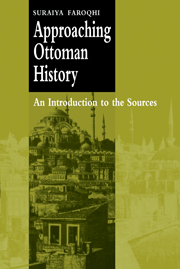Book contents
- Frontmatter
- Contents
- List of illustrations
- Acknowledgements
- 1 Introduction
- 2 Entering the field
- 3 Locating Ottoman sources
- 4 Rural life as reflected in archival sources: selected examples
- 5 European sources on Ottoman history: the travellers
- 6 On the rules of writing (and reading) Ottoman historical works
- 7 Perceptions of empire: viewing the Ottoman Empire through general histories
- 8 Conclusion
- References
- Index
3 - Locating Ottoman sources
Published online by Cambridge University Press: 10 November 2009
- Frontmatter
- Contents
- List of illustrations
- Acknowledgements
- 1 Introduction
- 2 Entering the field
- 3 Locating Ottoman sources
- 4 Rural life as reflected in archival sources: selected examples
- 5 European sources on Ottoman history: the travellers
- 6 On the rules of writing (and reading) Ottoman historical works
- 7 Perceptions of empire: viewing the Ottoman Empire through general histories
- 8 Conclusion
- References
- Index
Summary
MANUSCRIPTS AND BOOK COLLECTING
Down into the nineteenth century, when printing became more widespread in the Ottoman realm, most books were manuscripts preserved by collectors, and by copyists who manufactured additional volumes on demand. Many books found their way into endowed libraries. These were numerous especially in Istanbul, either as parts of larger foundations, or, particularly since the seventeenth century, as separate institutions. Most of these manuscript collections have now been brought together in the sixteenth-century buildings of the Süleymaniye. In the provinces, such foundation-sponsored libraries were much less common than in Istanbul (for a union catalogue of Turkish manuscripts, see Collective work, 1979–). But in Konya, there existed and still exists the famed manuscript collection of the Mevlevi dervishes (catalogue published by Gölpinarli, 1967–72). This library contains such treasures as Elvan Çelebi's fourteenth-century biography of the rebel dervish Baba Ilyas, which we have already encountered (Elvan Çelebi, ed. Erünsal and Ocak, 1984). In the İl Halk Kütüphanesi of the same city, a number of manuscripts go back to another famed thirteenth-century collection, assembled by the mystic Sadreddin-i Konevi. This was the son-in-law and follower of Ibn ‘Arabī, one of the great figures of Islamic mysticism. When Sultan Mehmed the Conqueror annexed Konya to the Ottoman Empire in the mid-fifteenth century, he or some of his leading officials apparently were much impressed by these manuscripts. Thus they were recorded in the register of pious foundations prepared immediately after the conquest, and the list was copied several times in the course of the next century (Uzluk, 1958, p. 11).
- Type
- Chapter
- Information
- Approaching Ottoman HistoryAn Introduction to the Sources, pp. 46 - 81Publisher: Cambridge University PressPrint publication year: 1999

